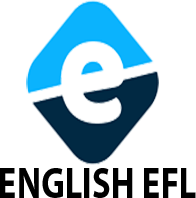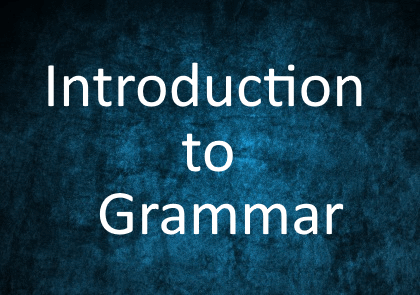Basic English grammar
Small children seem to have an intuitive grasp of language structure – which is why they sometimes make mistakes, assuming principles that are not always true. If you hear a child talk about ‘two mouses’ he is not repeating something he has heard; he has understood the concept that we add the sound ‘-es’ to a word ending in a ‘s’ sound, to create a plural. If he says, ‘the two mouses runned away’, you know he has also understood that to create a past tense we usually add the ending ‘-ed’ to a verb. Obviously there’s no need to ‘correct’ a child who uses unconventional (though logical) forms like this; he will gradually learn the various exceptions as he grows up. Many parents would say,’Yes, the two mice ran away’ which gives the correct grammar while agreeing with the content of what the child has said; that’s how most grammar is learned.
Why study grammar?
If it’s intuitive, and learned in the toddler years, what’s the point of learning about parts of speeh and grammar in general?
Firstly, it can help us in writing if we know how our language is correctly used. Conversation tends to be casual, but when we write letters, or job applications, or articles, it’s important to know correct grammar if we are not to appear ignorant. For instance, the phrase ‘could have’ is often pronounced ‘could’ve’ when we’re talking. Unfortunately, people who don’t understand grammar sometimes write or type it as ‘could of’, which sounds the same but is incorrect. Spell-checkers don’t help with this kind of mistake, nor with the differences between ‘your’ and ‘you’re’ or ‘its’ and ‘it’s’.
Secondly, if you learn a foreign language when you’re a teenager or adult, the grammar is likely to work differently. If you learn as a small child, you will understand this intuitively, as with a first language. But by the time we get to eight or nine, our brains have become somewhat hard-wired as far as language goes, and it’s much more difficult to learn a new one. So it becomes important to see how the grammatical structure works – and unless we understand English grammar first, that’s almost impossible.
Thirdly, it’s interesting to study grammar, so long as you don’t treat it as a chore!
Parts of speech
Our language has around a quarter of a million distinct words. Amazingly, these can be divided, grammatically speaking, into just eight kinds of word, which are known as ‘parts of speech’. These are:
- nouns
- verbs
- prounouns
- adjectives
- adverbs
- prepositions
- conjunctions
- interjections
Nouns
The first words your child learns as a baby are likely to be nouns, which are – broadly – words describing things, people or places. Ball, or cat, or milk, or fire-engine are all examples of nouns. A ‘proper noun’ is a variety of noun which we usually write with a capital letter, which gives a specific name to a particular example of a noun. So ‘man’ is an ordinary noun, but ‘Grandpa’ or ‘Mr Smith’ are proper nouns.
A noun doesn’t have to describe something we can see or touch, although at first these are the nouns your toddler will understand. ‘Abstract nouns’ describe concepts: for instance beauty, love, greed, happiness.
Verbs
When your child starts stringing words together to make phrases, they will almost certainly include a verb as well as a noun. A verb is an important part of speech that describes something that is happening, or being done. Examples of verbs are: run, jump, think, like, find. A toddler can communicate pretty well with just nouns and verbs: ‘Johnny want biscuit’, ‘cuddle Mummy’, ‘see Teletubbies’.
Verbs have many forms that help us understand who is being referred to, when the action takes place, and so on. But they all form out of the basicroot which is the simplest form of the verb, the one which a child almost certainly learns first.
Pronouns
If we only had nouns to describe people, places and things, our language would get rather convoluted and awkward. So we use pronouns – simple parts of speech – to refer to nouns we have already mentioned, or which we assume. Examples of pronouns are: me, you, it, him. As your child progresses through toddlerhood you’ll notice that he stops saying, ‘Johnny want biscuit’, and learns instead, ‘I want biscuit’. If you think about it, it’s pretty complex that we all refer to ourselves as ‘I’ even though we all have different names. But, if you use use the pronouns correctly, he will pick up their correct use without too much difficulty, even if he makes a few mistakes along the way.
Adjectives
Since not every noun has a specific label, we can use another part of speech – an adjective – to describe certain aspects of someone or something we want to talk about. An adjective tells us more about a noun. Examples of adjectives are: nice, greedy, happy, smart. Colours are a form of adjective too. So we might talk about a tall man; a talkative child; a green car; a bouncy ball. A sentence usually makes sense without any adjectives, but they add a bit of interest to our conversation.
Two very important adjectives are the articles, ‘the’ and ‘a’ (or ‘an’). These are also used to refer to specific or general nouns – as I’ve already done in the examples above. We never find these words used on their own; they always refer to a person, place or thing.
Adverbs
Another part of speech that helps us explain in more detail what we are talking about is an adverb. Adverbs tell us more about the verbs we are using, and often (though not always) end in -ly, such as nicely, greedily, happily, smartly. So we might say: he walked slowly; she spoke thoughtfully; the children played noisily.
Prepositions
The five parts of speech described briefly above form the majority of our conversation. But there are three more important types of word. A preposition is a rather long word describing a word that is usually very short, such as: by, with, after, before. A preposition shows us the relationship of one object to another. So we might say: the cat is in the garden; the girl sat between her parents; my shoes are under the bed.
Conjunctions
Another long word describing something short is a conjunction. This is a word that links words or parts of sentences together, or contrasts them, such as and, so, until, therefore. So we might say: James and John were asleep, but Joshua was awake; I couldn’t get to sleep while the radio was on; if you’re ready, we’ll go out.
Interjections
Finally, and relatively unimportant, comes the interjection. These are just simple words that usually express strong emotion, coming alone or at the start of a sentence, such as Oh!, Well, or Hooray!. So we might say,Wow! That was brilliant; Goodness, I don’t know how you did that; Oh boy, that was tricky.
Playing with grammar
Not all words are as easy to categorise as the examples given, but every word in the English language fits into one of the above eight parts of speech. If your children enjoy this kind of structure, you could try making word cards of different colours,or highlighting phrases on paper with different coloured pens, depending on the parts of speech. It’s best to begin with simple phrases, eg Jack and Jill went up the hill.
Let’s make the verb red. ;Where is the verb? That’s the thing that describes what happens. It’s the word ‘went’. Let’s make the nouns brown. Where are the nouns? There are two people and one thing: Jack and Jill are proper nouns, hill is an ordinary noun. What words are left: and, up and the. ‘and’ is a conjunction, joining Jack with Jill in the sentence, ‘the’ is an article, so it’s an adjective, and ‘up’ is a preposition. If we make conjunctions green, adjectives pink and prepositions purple, the sentence will read: Jack and Jill went up the hill.
If you repeat this kind of thing occasionally for fun, or when your children ask about words, grammar won’t seem like a tedious thing to study but may become a fascinating puzzle to work out. Not everyone will find it interest, but if your child does it’s a useful start to any kind of linguistics, modern languages or classics study. It can also help in categorising and logical thinking.


